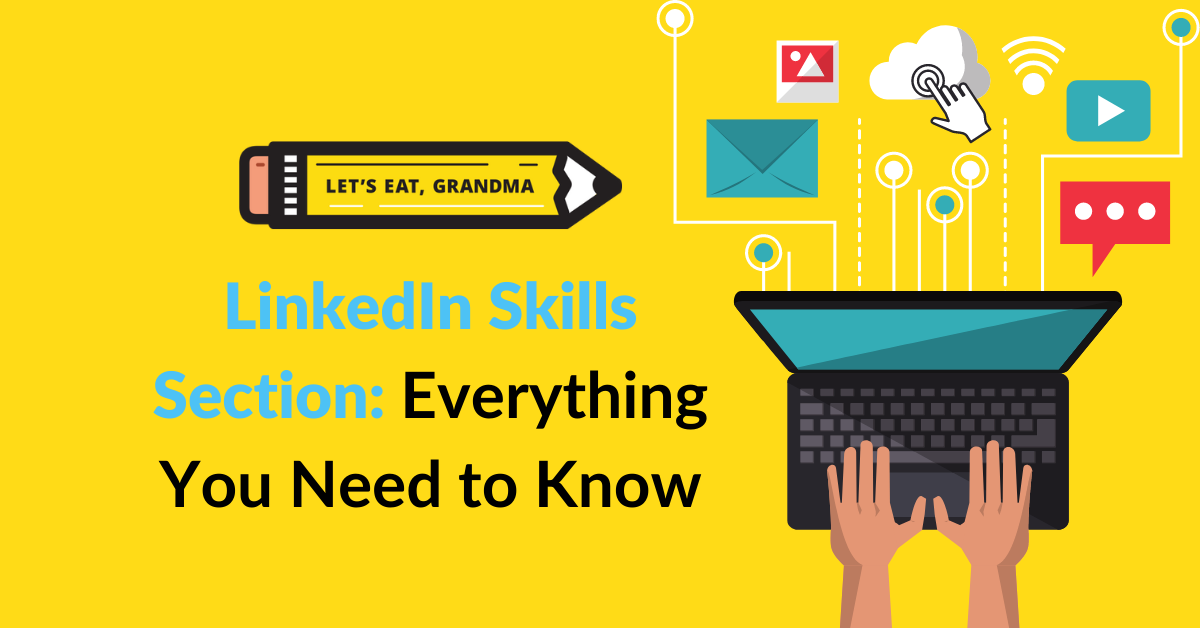Everything You Need for a Great LinkedIn Skills Section

Think your LinkedIn skills section is just like your resume’s skills section? Think again. Learn how to craft this underutilized section for better results in your job search.
Editor’s note: This post was originally published in May 2022; it has been updated for accuracy and comprehensiveness. Last update: January 2024.
By: Grace Mitchell | Contributor for Let’s Eat, Grandma
If you want your LinkedIn profile to help you land a job, a strong skills section is essential. Many job seekers don’t know how to use this section to its full potential, but lucky for you, we’ve got the tips and tricks you need to get this section working for you.
Before we dive in, though, it’s worth mentioning that your skills section is just one aspect of a strong, optimized LinkedIn profile.
Filling out this section completely and getting endorsements makes your profile more visible to recruiters, but that isn’t worth much if the rest of your profile is lacking.
Use the same attention to detail you devote to your skills section to all of your LinkedIn presence, and you’re bound to attract the attention your skills deserve.
Ready for more job search help?
Sign up for a free Senior Writer Resume Critique to see what’s holding you back from landing interviews. One of our top professional resume writers will give you personalized feedback on the top 3 items you can improve based on our expert practices!
Let’s Eat, Grandma is here to support you every step of the way in your job search journey. Before you get started optimizing your LinkedIn profile, request a free resume critique for honest feedback from a senior resume writer on your resume, and take the first step towards securing your dream job.
Now, let’s get into the nitty-gritty of what makes a great skills section, starting with how it differs from the skills section on your resume.
LinkedIn skills section vs resume skills section

Photo by Nathana Rebouças on Unsplash
While some job seekers simply copy over their skills from their resume in their LinkedIn skills section, this really isn’t the best way to go about it.
LinkedIn allows for up to 100 skills, a number we hope you aren’t approaching in your resume – remember, your resume should be as short and relevant as possible.
While your resume should only list those skills which directly relate to the specific job you’re applying for, LinkedIn gives you the space to add skills relevant to more jobs that you might be targeting.
Recruiters can easily skim through and seek out the skills they’re looking for, making this a great tool for those transitioning into new careers or starting a job search for the first time.
Our No. 1 tip: Fill the entire section
When we say that you can add up to 50 skills to this section, we really mean that you should use all 50 spaces given. Millions of recruiters use LinkedIn each day, and using as many terms as possible for your skills makes it more likely that your profile will come up in a search.
LinkedIn’s skill section gives users the option to auto-complete what they’re typing, so you can add synonyms for your skills in order to attract more recruiters.
For instance, my background is primarily in customer service, and my LinkedIn skills section lists “customer service,” “customer-focused service,” and “interpersonal skills” among my skills. While these terms are similar, I have no way of knowing which a recruiter would be more likely to search for or to add to add to a LinkedIn job description, so having all three in my profile gives me better odds of being found for relevant jobs.
While you should include industry-specific skills in your profile, don’t forget about transferable skills and other skills recruiters want to see. LinkedIn automatically sorts your skills into four categories: industry knowledge, tools and technologies, interpersonal skills, and other skills.
While you may be tempted to list only industry-specific skills, ideally, you’ll want a mix of all of these. After all, most jobs require some degree of knowledge about certain technologies, and recruiters like to know that a potential candidate plays well with others.
The importance of synonyms and variations

Cover all the bases by using synonyms for popular skills. Photo by Nathan Dumlao on Unsplash
Using synonyms for skills in your LinkedIn Skills section can be an effective way to increase the visibility of your profile to potential employers or recruiters. By including multiple variations of a skill, you can show that you have a diverse skill set and can adapt to different job requirements.
You may be wondering what synonyms to use for your specific industry. While this is in no way comprehensive, here are some skills synonyms for common industries:
Marketing
Digital marketing, content marketing, content strategy, online marketing, social media marketing, internet marketing
Management
Leadership, team leadership, mentoring, coaching
Software Engineering
Software development, web development, web engineering, front-end development, full-stack development
Nursing
Nursing practice, patient care, pediatric nursing, hospice care
This can help your profile appear in search results for a wider range of job opportunities.
You can also try searching for skills from your industry in LinkedIn’s search bar and looking through well-made profiles to get more ideas for skills to include. Look for users who have a strong headline and professional cover image, as these are more likely to have put time into filling out all their available skills.
Remember, it is important to ensure that the synonyms accurately reflect your actual skills and expertise to avoid misleading potential employers.
Choose your top 3 skills
While you can add 50 skills, only the top three will display on your profile unless the person reading it chooses to “see all skills.” That means the first three skills should be the ones that best represent what you have to offer.
Your top three will default to the three most-endorsed skills on your profile (more on endorsements later), but you can and should rearrange these in any order you like.
To reorder your skills, simply click the pencil on your skills section on your profile to edit, and then click the three dots on the following screen. The drop down gives you the option to reorder, allowing you to click the lines to the right of any skill and simply drag them to anywhere in the list you’d like.
Reordering your skills allows you to list your most relevant skills right away. This is also useful when making a career transition, as you can opt to make your transferable skills most prominent on your profile.
Take your LinkedIn skills to the next level with endorsements

Ask your connections for endorsements to boost the impact of your skills. Photo by Johan Godínez on Unsplash
“You really think someone would do that? Just go on the internet and tell lies?” There’s a reason this question Buster asks in the PBS classic Arthur became a meme, and it’s definitely not because the internet is known as a consistently reliable source.
Given the free rein users have over their LinkedIn profiles, how will recruiters know the information in your skills section is accurate?
LinkedIn makes this easy by allowing users to endorse their connections’ skills. Endorsements add to your credibility by confirming that people you’ve worked with have seen your skills in action and can verify that you have what it takes to call your skill a skill.
The internet may still be a place of lies, but at least on LinkedIn this user interaction shows others you’re legit (and helps you as a job seeker avoid scammers and other ne’er-do-wells).
Ask colleagues or managers to endorse you for your top skills. Or take a half hour to proactively give endorsements to your connections – it’s likely at least a few of the recipients will return the favor.
To give a connection an endorsement, simply go to their profile and click “endorse” under the skill you’d like to confirm. There’s no button to click to let someone know you’d like an endorsement, but you can also reach out to your connections and ask that they return the favor. (It’s also likely that if you’re generous with giving endorsements that others will endorse your skills even if you don’t ask, but don’t count on it.)
It’s also worth mentioning that endorsements aren’t the same as recommendations. An endorsement simply attests that you have a certain skill, while a recommendation is more of a broad review of how great you are to work with. Ideally you’ll want both, but they don’t serve the same purpose.
Help! I’m not good enough at ____ to list it as a skill!

Think about your interpersonal communication skills and daily tasks, as well as your technical aptitude, when considering what skills to put on LinkedIn. Photo by LinkedIn Sales Solutions on Unsplash
This section goes out to our fellow job seekers who struggle with imposter syndrome. You’re not alone, and we promise you’re far more capable than you think.
It’s easy to feel a bit stuck trying to think of 50 professional skills you trust you’re good enough to list. If that’s the case for you, we recommend thinking through a standard day at work. What tasks do you do every day? What do your coworkers and/or boss mention about your work? What are your favorite things that you get to do at work?
If you’re performing a task every day and don’t regularly struggle with it, then guess what! You’ve had enough experience to add it to your LinkedIn skills section.
If your coworkers laud your ability to problem-solve or how well you interact with children, not only should you list these in your profile, but you should also list synonyms and ask those coworkers if they’d be willing to endorse those skills for all to see.
For instance, in my work at my public library job, my coworkers often compliment my memory, which allows me to greet patrons by name when they come in. I can ask my coworkers to vouch for my attention to detail and interpersonal skills on LinkedIn for my next career move.
Finally, if there’s a part of your job that keeps you waking up and excited to do the work, you should follow that passion and allow it to open new doors for you in your career. Maybe you’re not an expert in JavaScript, but if you’re performing the task and excited about it, the skill will come. Consider listing a skill like this depending on how sure you are it will improve and how crucial it is to the jobs you want.
You can even take courses and take skills assessments within LinkedIn to strengthen and confirm your skills. At the top right corner of your skills section, there’s a button that says “Take skill quiz.” While taking courses to improve your skills requires a paid membership (or at least a trial), you can take 15-question quizzes in a variety of subjects to earn a badge that will appear on your profile.
You have the skills to succeed
Networking has come a long way in recent years, and LinkedIn’s essential role in this job search strategy only continues to grow. Crafting a LinkedIn profile that represents your brand and all you have to offer can be a gamechanger in the job search.
When used appropriately, your LinkedIn skills section can be a value tool to get you ahead in your job search. By listing 50 skills, moving your most relevant skills to the top of your list, getting endorsements, and owning what a pro you are in your work, you’re well on your way to crafting a LinkedIn profile that’s sure to attract recruiters.
Ready for more job search help?
Sign up for a free Senior Writer Resume Critique to see what's holding you back from landing interviews. One of our top professional resume writers will give you personalized feedback on the top 3 items you can improve based on our expert practices!
